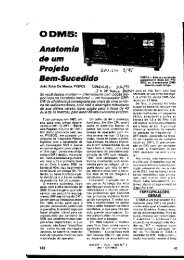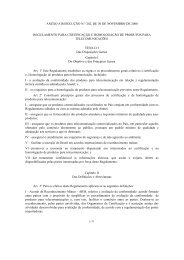A Software Defined Radio for the Masses, Part 3
A Software Defined Radio for the Masses, Part 3
A Software Defined Radio for the Masses, Part 3
You also want an ePaper? Increase the reach of your titles
YUMPU automatically turns print PDFs into web optimized ePapers that Google loves.
volution is often faster than direct convolution<br />
<strong>for</strong> filter kernels longer than<br />
64 taps, and it produces exactly <strong>the</strong><br />
same result.<br />
For me, FFT convolution is easier<br />
to understand than direct convolution<br />
because I mentally visualize filters in<br />
<strong>the</strong> frequency domain. As described in<br />
<strong>Part</strong> 1 of this series, <strong>the</strong> output of <strong>the</strong><br />
complex FFT may be thought of as a<br />
long bank of narrow band-pass filters<br />
aligned around <strong>the</strong> carrier frequency<br />
(bin 0), as shown in Fig 4. Fig 10 illustrates<br />
<strong>the</strong> process of FFT convolution<br />
of a trans<strong>for</strong>med filter impulse response<br />
with a trans<strong>for</strong>med input signal.<br />
Once <strong>the</strong> signal is trans<strong>for</strong>med<br />
back to <strong>the</strong> time domain by <strong>the</strong> inverse<br />
FFT, we must <strong>the</strong>n per<strong>for</strong>m a process<br />
called <strong>the</strong> overlap/add method. This<br />
is because <strong>the</strong> process of convolution<br />
produces an output signal that is<br />
equal in length to <strong>the</strong> sum of <strong>the</strong> input<br />
samples plus <strong>the</strong> filter taps minus<br />
one. I will not attempt to explain<br />
<strong>the</strong> concept here because it is best described<br />
in <strong>the</strong> references. 13<br />
Fig 11 provides <strong>the</strong> source code <strong>for</strong><br />
producing <strong>the</strong> frequency-domain<br />
band-pass filter coefficients. The<br />
CalcFilter subroutine is passed <strong>the</strong><br />
low-frequency cutoff, FLow, and <strong>the</strong><br />
high-frequency cutoff, FHigh, <strong>for</strong> <strong>the</strong><br />
filter response. The cutoff frequencies<br />
are <strong>the</strong>n converted to <strong>the</strong>ir respective<br />
fractions of <strong>the</strong> sampling rate <strong>for</strong> use<br />
by <strong>the</strong> filter-generation routine,<br />
nspdFirBandpass. The FFT order is<br />
also determined in this subroutine,<br />
based on <strong>the</strong> size of <strong>the</strong> FFT, NFFT.<br />
The nspdFirBandpass computes <strong>the</strong><br />
impulse response of <strong>the</strong> band-pass filter<br />
of bandwidth Fl() to Fh() and a<br />
length of FILTERTAPS. It <strong>the</strong>n places<br />
<strong>the</strong> result in <strong>the</strong> array variable Rh().<br />
The NSP_WinBlackmanOpt causes<br />
<strong>the</strong> impulse response to be windowed<br />
by a Blackman window function. For<br />
a discussion of windowing, refer to <strong>the</strong><br />
DSP Guide. 14 The value of one that is<br />
passed to <strong>the</strong> routine causes <strong>the</strong> result<br />
to be normalized.<br />
Next, <strong>the</strong> impulse response is converted<br />
to <strong>the</strong> frequency domain by<br />
nspzrFftNip. The input parameters<br />
are Rh(), <strong>the</strong> real part of <strong>the</strong> impulse<br />
response, and Ih(), <strong>the</strong> imaginary part<br />
that has been set to zero. NSP_Forw<br />
tells <strong>the</strong> routine to per<strong>for</strong>m <strong>the</strong> <strong>for</strong>ward<br />
FFT. We next convert <strong>the</strong> frequency-domain<br />
result of <strong>the</strong> FFT, reH()<br />
and imH(), to polar <strong>for</strong>m using <strong>the</strong><br />
nspdbrCartToPolar routine. The filter<br />
magnitudes, filterM(), and filter phase,<br />
filterP(), are stored <strong>for</strong> use in <strong>the</strong> FFT<br />
fast convolution filter. O<strong>the</strong>r than<br />
when we manually change <strong>the</strong> bandpass<br />
filter selection, <strong>the</strong> filter response<br />
does not change. This means that we<br />
6 Nov/Dec 2002<br />
nspdbMpy2 filterM, M, NFFT ‘Multiply Magnitude Bins<br />
nspdbAdd2 filterP, P, NFFT ‘Add Phase Bins<br />
Figure 12 – FFT Fast Convolution Filtering Code Using Polar Vectors<br />
‘Compute: RealIn(s) = (RealOut(s) * reH(s)) - (ImagOut(s) * imH(s))<br />
nspdbMpy3 RealOut, reH, RealOut_1, NFFT<br />
nspdbMpy3 ImagOut, imH, ImagOut_1, NFFT<br />
nspdbSub3 RealOut_1, ImagOut_1, RealIn, NFFT ‘RealIn <strong>for</strong> IFFT<br />
‘Compute: ImagIn(s) = (RealOut(s) * imH(s)) + (ImagOut(s) * reH(s))<br />
nspdbMpy3 RealOut, imH, RealOut_2, NFFT<br />
nspdbMpy3 ImagOut, reH, ImagOut_2, NFFT<br />
nspdbAdd3 RealOut_2, ImagOut_2, ImagIn, NFFT ‘ImagIn <strong>for</strong> IFFT<br />
Figure 13 – Alternate FFT Fast Convolution Filtering Code Using Cartesian Vectors<br />
Fig 14—Actual 500-Hz CW filter pass-band display. FFT fast-convolution filtering is used<br />
with 2048 filter taps to produce a 1.05 shape factor from 3 dB to 60 dB down and over<br />
120 dB of stop-band attenuation just 250 Hz beyond <strong>the</strong> 3 dB points.<br />
‘Convert polar to cartesian<br />
nspdbrPolarToCart M, P, RealIn, ImagIn, NFFT<br />
‘Inverse FFT to convert back to time domain<br />
nspzrFftNip RealIn, ImagIn, RealOut, ImagOut, order, NSP_Inv<br />
‘Overlap and Add from last FFT/IFFT: RealOut(s) = RealOut(s) + Overlap(s)<br />
nspdbAdd3 RealOut, IOverlap, RealOut, FILTERTAPS - 2<br />
nspdbAdd3 ImagOut, QOverlap, ImagOut, FILTERTAPS - 2<br />
‘Save Overlap <strong>for</strong> next pass<br />
For S = BLKSIZE To NFFT - 1<br />
IOverlap(S - BLKSIZE) = RealOut(S)<br />
QOverlap(S - BLKSIZE) = ImagOut(S)<br />
Next<br />
Figure 15 – Inverse FFT and Overlap/Add Code











